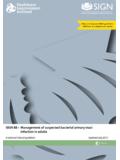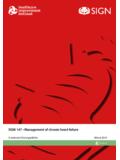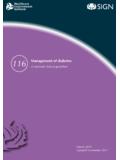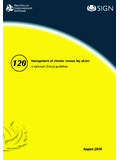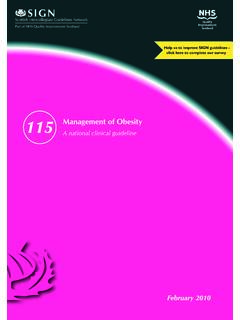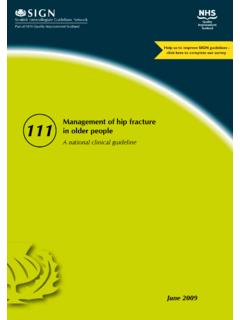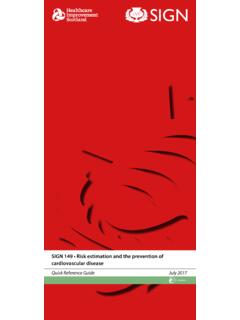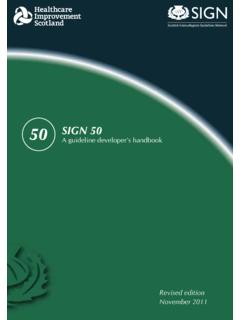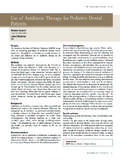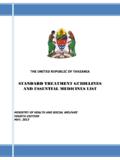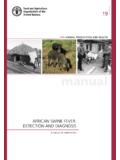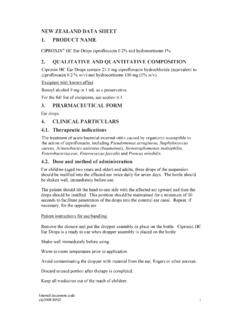Transcription of SIGN 88 • Management of suspected bacterial …
1 SIGN 88 management of suspected bacterial urinary tract infection in adults A national clinical guideline Updated July 2012 EvidenceHelp us to improve SIGN guidelines -click here to complete our survey KEY TO EVIDENCE STATEMENTS AND GRADES OF RECOMMENDATIONSLEVELS OF EVIDENCE1++High quality meta-analyses, systematic reviews of RCTs, or RCTs with a very low risk of bias1+Well conducted meta-analyses, systematic reviews, or RCTs with a low risk of bias1 -Meta-analyses, systematic reviews, or RCTs with a high risk of bias2++ High quality systematic reviews of case control or cohort studies High quality case control or cohort studies with a very low risk of confounding or bias and a high probability that the relationship is causal2+Well conducted case control or cohort studies with a low risk of confounding or bias and a moderate probability that the relationship is causal2 - Case control or cohort studies with a high risk of confounding or bias and a significant risk that the relationship is not causal3 Non-analytic studies, eg case reports, case series4 Expert opinionGRADES OF RECOMMENDATIONNote: The grade of recommendation relates to the strength of the evidence on which the recommendation is based.
2 It does not reflect the clinical importance of the At least one meta-analysis, systematic review, or RCT rated as 1++, and directly applicable to the target population; or A body of evidence consisting principally of studies rated as 1+, directly applicable to the target population, and demonstrating overall consistency of resultsBA body of evidence including studies rated as 2++, directly applicable to the target population, and demonstrating overall consistency of results; orExtrapolated evidence from studies rated as 1++ or 1+CA body of evidence including studies rated as 2+, directly applicable to the target population and demonstrating overall consistency of results; orExtrapolated evidence from studies rated as 2++DEvidence level 3 or 4; orExtrapolated evidence from studies rated as 2+GOOD PRACTICE POINTS Recommended best practice based on the clinical experience of the guideline development groupNHS Evidence has accredited the process used by Scottish Intercollegiate Guidelines Network to produce guidelines.
3 Accreditation is valid for three years from 2009 and is applicable to guidance produced using the processes described in SIGN 50: a guideline developer s handbook, 2008 edition ( ). More information on accreditation can be viewed at Improvement Scotland (HIS) is committed to equality and diversity and assesses all its publications for likely impact on the six equality groups defined by age, disability, gender, race, religion/belief and sexual guidelines are produced using a standard methodology that has been equality impact assessed to ensure that these equality aims are addressed in every guideline. This methodology is set out in the current version of SIGN 50, our guideline manual, which can be found at The EQIA assessment of the manual can be seen at The full report in paper form and/or alternative format is available on request from the NHS QIS Equality and Diversity care is taken to ensure that this publication is correct in every detail at the time of publication.
4 However, in the event of errors or omissions corrections will be published in the web version of this document, which is the definitive version at all times. This version can be found on our web site This document is produced from elemental chlorine-free material and is sourced from sustainable Intercollegiate Guidelines NetworkManagement of suspected bacterial urinary tract infection in adultsA national clinical guidelineJuly 2012 Management of suspected bacterial urinary tract infection in adultsScottish Intercollegiate Guidelines Network Elliott House, 8 -10 Hillside Crescent Edinburgh EH7 5EA published July 2006 Updated edition published July 2012 ISBN 978 1 905813 88 9 Citation textScottish Intercollegiate Guidelines Network (SIGN).
5 Management of suspected bacterial urinary tractinfection in adults. Edinburgh: SIGN; 2012. (SIGN publication no. 88). [July 2012]. Available from URL: consents to the photocopying of this guideline for the purpose of implementation in of suspected bacterial urinary tract infection in adultsContents1 Introduction .. The need for a guideline .. Remit of the guideline .. Definitions .. Key messages about bacterial UTI .. Epidemiology .. Statement of intent ..52 Key recommendations .. Management of bacterial UTI in adult women .. Management of bacterial UTI in pregnant women .. Management of bacterial UTI in adult men .. Management of bacterial UTI in patients with Management of bacterial UTI in adult women.
6 Diagnosis .. Near patient testing .. Urine culture .. Antibiotic treatment .. Non-antibiotic Referral .. Cost-effective treatment in primary care ..154 Management of bacterial UTI in pregnant Diagnosis .. Near patient testing .. Antibiotic treatment .. Screening during pregnancy ..185 Management of bacterial UTI in adult men .. Diagnosis .. Antibiotic treatment .. Referral ..206 Management of bacterial UTI in patients with catheters .. Diagnosis .. Near patient testing .. Antibiotic prophylaxis to prevent catheter-related UTI .. Antibiotic treatment .. Management of bacterial uti in patients with urinary stomas ..247 Provision of information .. Sources of further information.
7 Key issues ..26 ContentsManagement of suspected bacterial urinary tract infection in adultsManagement of suspected bacterial urinary tract infection in General advice ..278 Implementing the guideline .. Implementation strategy .. Auditing current practice .. Implementation and audit of the recommendations .. Recommendations for surveillance ..329 The evidence base .. Systematic literature review .. Recommendations for research .. Review and updating ..3310 Development of the guideline .. The guideline development group .. The guideline review group .. Consultation and peer review ..36 Abbreviations ..37 Annex .. of suspected bacterial urinary tract infection in adultsManagement of suspected bacterial urinary tract infection in adults| 11 Introduction1 Introduction THE NEED foR A GUIDElINE Urinary tract infection (UTI) is the second most common clinical indication for empirical antimicrobial treatment in primary and secondary care, and urine samples constitute the largest single category of specimens examined in most medical microbiology Healthcare practitioners regularly have to make decisions about prescription of antibiotics for urinary tract infection.
8 Criteria for the diagnosis of urinary tract infection vary greatly in the UK, depending on the patient and the context. There is considerable evidence of practice variation in use of diagnostic tests, interpretation of signs or symptoms and initiation of antibiotic treatment,2-5 with continuing debate regarding the most appropriate diagnosis and , 6 The diagnosis of UTI is particularly difficult in elderly patients, who are more likely to have asymptomatic bacteriuria as they get The prevalence of bacteriuria may be so high that urine culture ceases to be a diagnostic Elderly institutionalised patients frequently receive unnecessary antibiotic treatment for asymptomatic bacteriuria despite clear evidence of adverse effects with no compensating clinical.
9 10 Existing evidence based guidelines tend to focus on issues of antibiotic treatment (drug selection, dose, duration and route of administration) with less emphasis on clinical diagnosis or the use of near patient tests or are limited to adult, non-pregnant women with uncomplicated, symptomatic ,12 For patients with symptoms of urinary tract infection and bacteriuria the main aim of treatment is relief of symptoms. Secondary outcomes are adverse effects of treatment or recurrence of symptoms. For asymptomatic patients the main outcome from treatment is prevention of future symptomatic episodes. Unnecessary use of tests and antibiotic treatment may be minimised by developing simple decision rules, diagnostic guidelines or other educational Prudent antibiotic prescribing is a key component of the UK s action plans for reducing antimicrobial ,18 Unnecessary antibiotic treatment of asymptomatic bacteriuria is associated with significantly increased risk of clinical adverse events19-21 including Clostridium difficile infection (CDI) or methicillin resistant Staphylococcus aureus (MRSA) infection, and the development of antibiotic-resistant UTIs.
10 In people aged over 65 years asymptomatic bacteriuria is common but is not associated with increased In patients with an indwelling urethral catheter, antibiotics do not generally eradicate asymptomatic UPDATING THE EvIDENCE This guideline updates SIGN 88: Management of suspected bacterial urinary tract infection in adults, published in 2006. The update replaces recommendations on prescribing with reference to local prescribing protocols. The risks of CDI and MRSA are also discussed. This update has not addressed any new questions, but has set the existing recommendations more clearly in the context of the need to minimise the risk of antibiotic-resistant organisms developing greater resistance. The original supporting evidence was not re-appraised by the current guideline development group and no new evidence has been assessed.
